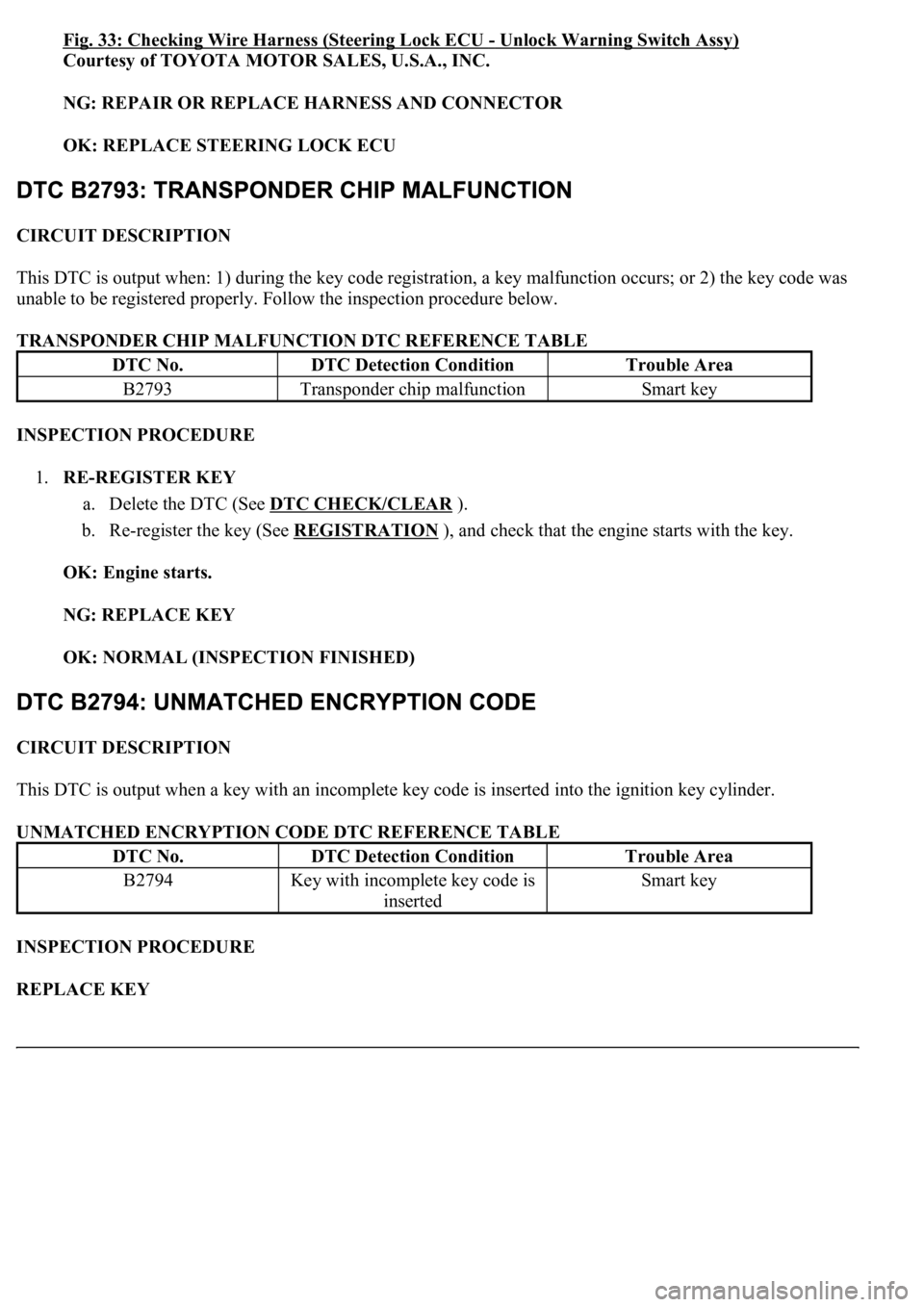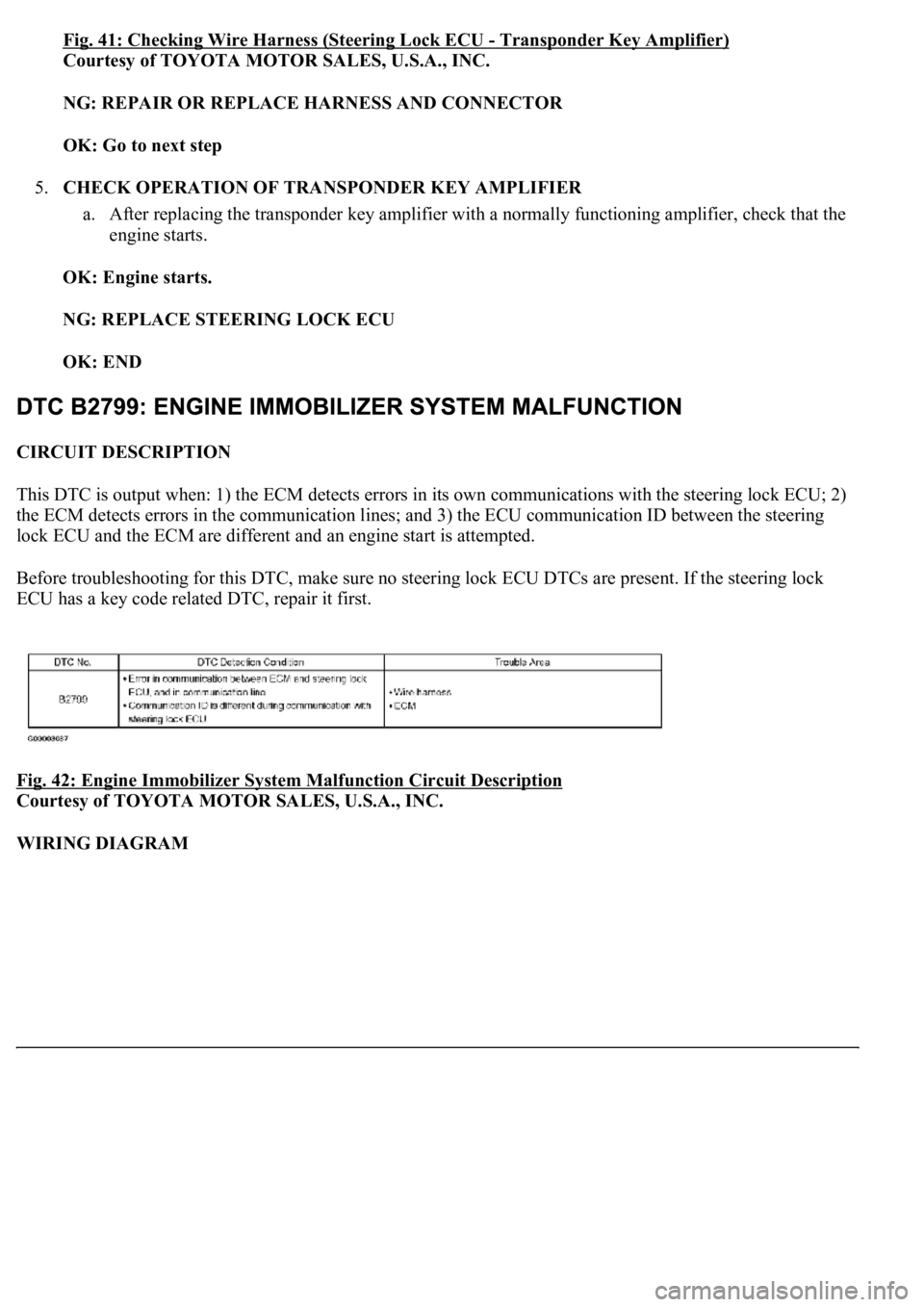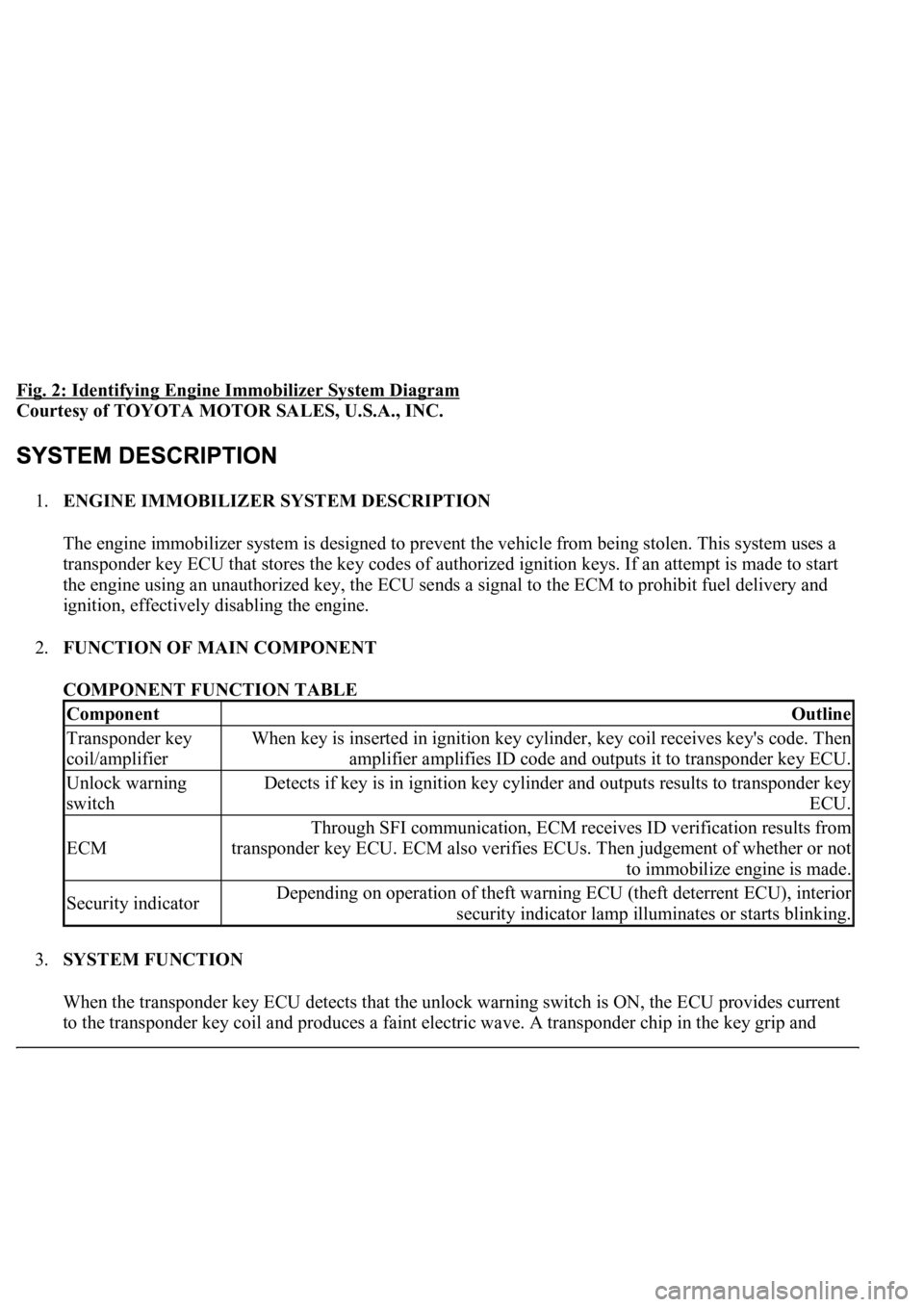Page 3207 of 4500

Fig. 33: Checking Wire Harness (Steering Lock ECU -Unlock Warning Switch Assy)
Courtesy of TOYOTA MOTOR SALES, U.S.A., INC.
NG: REPAIR OR REPLACE HARNESS AND CONNECTOR
OK: REPLACE STEERING LOCK ECU
CIRCUIT DESCRIPTION
This DTC is output when: 1) during the key code registration, a key malfunction occurs; or 2) the key code was
unable to be registered properly. Follow the inspection procedure below.
TRANSPONDER CHIP MALFUNCTION DTC REFERENCE TABLE
INSPECTION PROCEDURE
1.RE-REGISTER KEY
a. Delete the DTC (See DTC CHECK/CLEAR
).
b. Re-register the key (See REGISTRATION
), and check that the engine starts with the key.
OK: Engine starts.
NG: REPLACE KEY
OK: NORMAL (INSPECTION FINISHED)
CIRCUIT DESCRIPTION
This DTC is output when a key with an incomplete key code is inserted into the ignition key cylinder.
UNMATCHED ENCRYPTION CODE DTC REFERENCE TABLE
INSPECTION PROCEDURE
REPLACE KEY
DTC No.DTC Detection ConditionTrouble Area
B2793Transponder chip malfunctionSmart key
DTC No.DTC Detection ConditionTrouble Area
B2794Key with incomplete key code is
insertedSmart key
Page 3208 of 4500
CIRCUIT DESCRIPTION
This DTC is output when a key with a key code that has not been registered in the ECU is inserted into the
ignition key cylinder.
UNMATCHED KEY CODE DTC REFERENCE TABLE
INSPECTION PROCEDURE
1.DELETE DTC AND INSERT ALL PRESENTLY AVAILABLE KEYS TO CHECK WHETHER
ENGINE STARTS OR NOT
OK: Engine starts.
NG: REPLACE KEY THAT CANNOT START ENGINE
OK: NO PROBLEM (BECAUSE OF KEY RE-REGISTRATION)
CIRCUIT DESCRIPTION
This DTC is output when a key that does not have a transponder chip is inserted into the ignition key cylinder or
if communication between the key and steering lock ECU is not possible.
Fig. 34: Communication Malfunction Circuit Description
Courtesy of TOYOTA MOTOR SALES, U.S.A., INC.
WIRING DIAGRAM
DTC No.DTC Detection ConditionTrouble Area
B2795Key with unregistered key code is
insertedSmart key
Page 3209 of 4500
Fig. 35: No Communication In Immobilizer System, DTC B2798: Communication Malfunction No. 2
DTC - Wiring Diagram
Courtesy of TOYOTA MOTOR SALES, U.S.A., INC.
INSPECTION PROCEDURE
1.READ DATA LIST USING HAND-HELD TESTER
a. Connect the hand-held tester to the CAN VIM. Then connect the CAN VIM to the DLC3.
b. Turn the ignition switch ON with the key that cannot start the engine.
c. Read the DATA LIST.
Steering lock ECU:
DATA LIST - STEERING LOCK ECU
OK: "UNSET" (Ignition switch ON) appears on the screen.
NG: Go to step 2
OK: REPLACE STEERING LOCK ECU
2.CHECK WHETHER ENGINE STARTS WITH OTHER KEYS
a. Check if the en
gine starts with the vehicle's other keys.
Item
Measurement Item/
Display (Range)
Normal ConditionDiagnostic Note
IMMOBILIZERImmobilizer system
status/ SET or UNSETUNSET: Ignition switch
ON SET: Without key-
Page 3210 of 4500
OK: Engine starts.
NG: Go to step 3
OK: RE-REGISTER OR REPLACE KEY THAT CANNOT START ENGINE
3.CHECK WIRE HARNESS (STEERING LOCK ECU - TRANSPONDER KEY AMPLIFIER)
a. Disconnect the S46 ECU connector.
b. Disconnect the T8 amplifier connector.
c. Measure the resistance of the wire harness side connectors.
Standard:
STEERING LOCK ECU - TRANSPONDER KEY AMPLIFIER - RESISTANCE TABLE
Tester connectionSpecified condition
S46-7 (VC5) - T8-1 (VC5)Below 1 ohms
S46-17 (CODE) - T8-4 (CODE)Below 1 ohms
S46-8 (RXCK) - T8-3 (RXCK)Below 1 ohms
S46-16 (TXCT) - T8-1 (TXCT)Below 1 ohms
S46-7 (VC5) or T8-1 (VC5) - Body ground10 kohms or higher
S46-17 (CODE) or T8-4 (CODE) - Body ground10 kohms or higher
S46-8 (RXCK) or T8-3 (RXCK) - Body ground10 kohms or higher
S46-16 (TXCT) or T8-5 (TXCT) - Body ground10 kohms or higher
Page 3212 of 4500
Fig. 36: Checking Wire Harness (Steering Lock ECU -Transponder Key Amplifier)
Courtesy of TOYOTA MOTOR SALES, U.S.A., INC.
NG: REPAIR OR REPLACE HARNESS AND CONNECTOR
OK: Go to next step
4.REPLACE TRANSPONDER KEY AMPLIFIER
a. After replacing the transponder key amplifier with a normally functioning amplifier, check that the
engine starts.
OK: Engine starts.
NG: REPLACE STEERING LOCK ECU
OK: END
CIRCUIT DESCRIPTION
This DTC is output when a communication error occurs between the transponder key amplifier and steering
lock ECU. Some possible reasons for the communication error are: 1) 2 or more smart keys are positioned too
close together, or 2) noise is occurring in the communication line. Follow the inspection procedure below.
Fig. 37: Communication Malfunction No. 1 Circuit Description
Courtesy of TOYOTA MOTOR SALES, U.S.A., INC.
WIRING DIAGRAM
Page 3218 of 4500

Fig. 41: Checking Wire Harness (Steering Lock ECU -Transponder Key Amplifier)
Courtesy of TOYOTA MOTOR SALES, U.S.A., INC.
NG: REPAIR OR REPLACE HARNESS AND CONNECTOR
OK: Go to next step
5.CHECK OPERATION OF TRANSPONDER KEY AMPLIFIER
a. After replacing the transponder key amplifier with a normally functioning amplifier, check that the
engine starts.
OK: Engine starts.
NG: REPLACE STEERING LOCK ECU
OK: END
CIRCUIT DESCRIPTION
This DTC is output when: 1) the ECM detects errors in its own communications with the steering lock ECU; 2)
the ECM detects errors in the communication lines; and 3) the ECU communication ID between the steering
lock ECU and the ECM are different and an engine start is attempted.
Before troubleshooting for this DTC, make sure no steering lock ECU DTCs are present. If the steering lock
ECU has a key code related DTC, repair it first.
Fig. 42: Engine Immobilizer System Malfunction Circuit Description
Courtesy of TOYOTA MOTOR SALES, U.S.A., INC.
WIRING DIAGRAM
Page 3219 of 4500
Fig. 43: Engine Immobilizer System Malfunction - Wiring Diagram
Courtesy of TOYOTA MOTOR SALES, U.S.A., INC.
INSPECTION PROCEDURE
1.CHECK WIRE HARNESS (STEERING LOCK ECU - ECM)
a. Disconnect the S46 ECU connector.
b. Disconnect the E2 ECM connector
c. Measure the resistance of the wire harness side connectors.
Standard:
STEERING LOCK ECU - ECM - RESISTANCE TABLE
Tester connectionSpecified condition
S46-13 (EFIO) - E2-6 (IMI)Below 1 ohms
S46-4 (EFII) - E2-7 (IMO)Below 1 ohms
S46-13 (EFIO) or E2-6 (IMI) - Body ground10 kohms or higher
S46-4 (EFII) or E2-7 (IMO) - Body ground10 kohms or higher
Page 3226 of 4500

Fig. 2: Identifying Engine Immobilizer System Diagram
Courtesy of TOYOTA MOTOR SALES, U.S.A., INC.
1.ENGINE IMMOBILIZER SYSTEM DESCRIPTION
The engine immobilizer system is designed to prevent the vehicle from being stolen. This system uses a
transponder key ECU that stores the key codes of authorized ignition keys. If an attempt is made to start
the engine using an unauthorized key, the ECU sends a signal to the ECM to prohibit fuel delivery and
ignition, effectively disabling the engine.
2.FUNCTION OF MAIN COMPONENT
COMPONENT FUNCTION TABLE
3.SYSTEM FUNCTION
When the transponder key ECU detects that the unlock warning switch is ON, the ECU provides current
to the transponder ke
y coil and produces a faint electric wave. A transponder chip in the key grip and
ComponentOutline
Transponder key
coil/amplifierWhen key is inserted in ignition key cylinder, key coil receives key's code. Then
amplifier amplifies ID code and outputs it to transponder key ECU.
Unlock warning
switchDetects if key is in ignition key cylinder and outputs results to transponder key
ECU.
ECM
Through SFI communication, ECM receives ID verification results from
transponder key ECU. ECM also verifies ECUs. Then judgement of whether or not
to immobilize engine is made.
Security indicatorDepending on operation of theft warning ECU (theft deterrent ECU), interior
security indicator lamp illuminates or starts blinking.